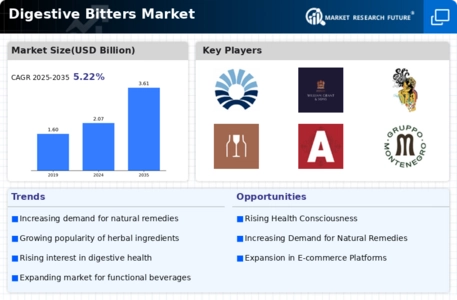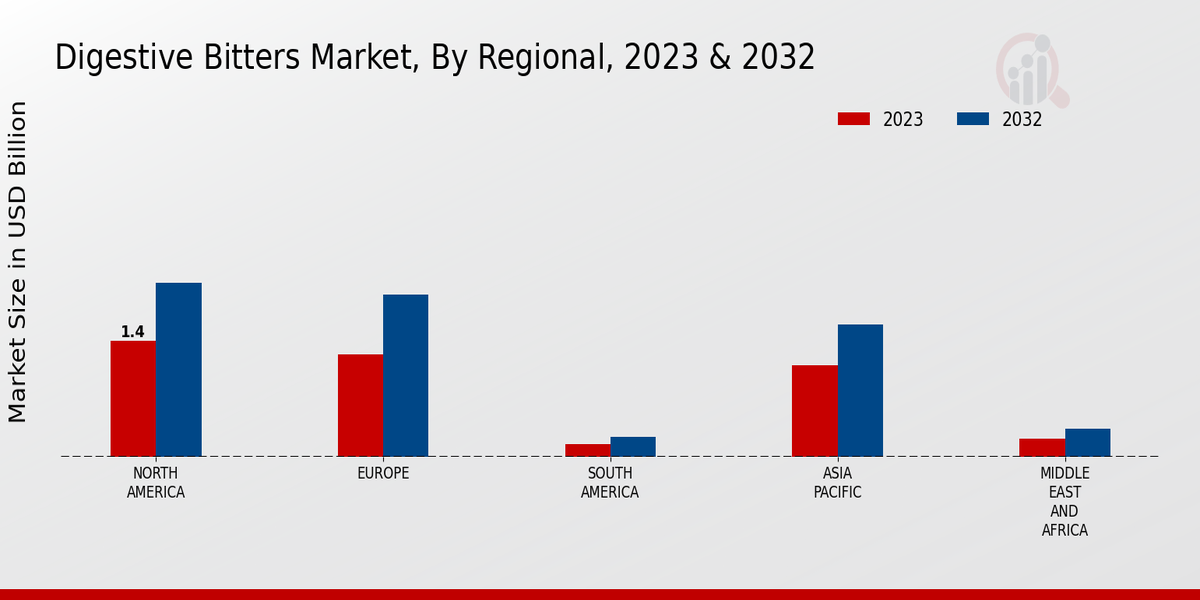Market Growth Projections
The Global Digestive Bitters Market Industry is poised for substantial growth, with projections indicating a market value of 2.07 USD Billion in 2024 and an anticipated increase to 3.61 USD Billion by 2035. This growth trajectory suggests a compound annual growth rate (CAGR) of 5.19% from 2025 to 2035. Such figures reflect the increasing consumer interest in digestive health products and the expanding availability of digestive bitters in various markets. The industry appears to be on a promising path, driven by evolving consumer preferences and a growing recognition of the benefits associated with digestive bitters.
Growing Health Consciousness
The increasing awareness of health and wellness among consumers is a pivotal driver for the Global Digestive Bitters Market Industry. As individuals seek natural remedies to enhance digestive health, the demand for digestive bitters is likely to rise. This trend is evident in the growing preference for herbal and organic products, which are perceived as healthier alternatives to synthetic options. The market is projected to reach 2.07 USD Billion in 2024, indicating a robust interest in products that support digestive functions. This shift towards natural health solutions suggests that the industry will continue to thrive as consumers prioritize their well-being.
Expansion of E-commerce Platforms
The rise of e-commerce platforms is transforming the Global Digestive Bitters Market Industry by providing consumers with greater access to a diverse range of products. Online shopping has become increasingly popular, allowing consumers to conveniently purchase digestive bitters from the comfort of their homes. This trend is particularly relevant in the context of a global market that is projected to grow at a CAGR of 5.19% from 2025 to 2035. E-commerce not only facilitates the distribution of products but also enables brands to reach a wider audience, thereby enhancing market penetration and driving sales growth in the digestive bitters sector.
Rising Demand for Natural Remedies
The Global Digestive Bitters Market Industry is experiencing a surge in demand for natural remedies, driven by a shift in consumer preferences towards holistic health solutions. Many individuals are increasingly turning to herbal products, including digestive bitters, as alternatives to conventional medications. This trend is supported by a growing body of evidence suggesting that natural ingredients can effectively aid digestion and alleviate gastrointestinal discomfort. As the market evolves, it is anticipated that the industry will expand significantly, with projections indicating a market value of 3.61 USD Billion by 2035. This growth reflects a broader societal movement towards embracing natural health practices.
Increased Focus on Digestive Health
The heightened focus on digestive health among consumers is a significant driver for the Global Digestive Bitters Market Industry. As awareness of the gut's role in overall health expands, individuals are actively seeking products that promote digestive wellness. Digestive bitters, known for their ability to stimulate digestive enzymes and improve gut function, are increasingly being recognized as beneficial. This trend is reflected in the market's projected growth, with expectations of reaching 2.07 USD Billion in 2024. The emphasis on digestive health is likely to continue influencing consumer choices, thereby propelling the industry forward.
Cultural Influence and Traditional Practices
Cultural influences and traditional practices play a crucial role in shaping the Global Digestive Bitters Market Industry. Many cultures have long utilized bitters as digestive aids, and this heritage continues to resonate with consumers today. The revival of interest in traditional remedies is driving the demand for digestive bitters, as consumers seek authentic products that connect them to their cultural roots. This trend is expected to contribute to the market's growth, with projections indicating a value of 3.61 USD Billion by 2035. The integration of cultural narratives into marketing strategies may further enhance consumer engagement and brand loyalty.






















Leave a Comment